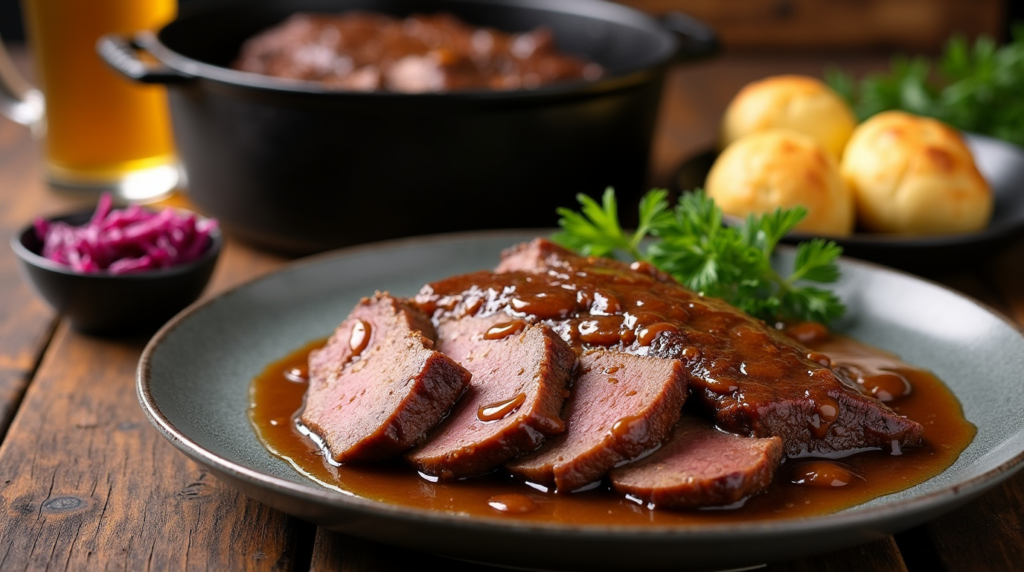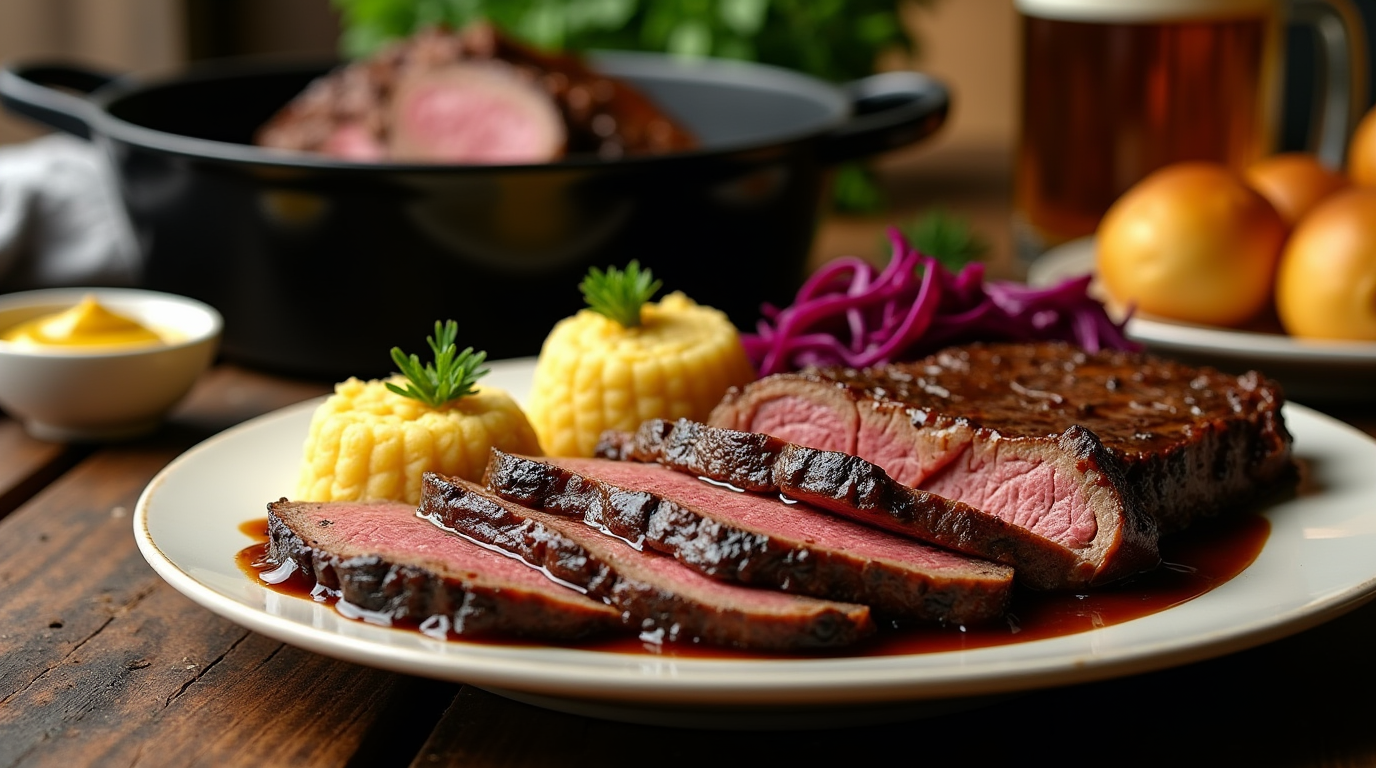German Sauerbraten Step-by-Step Guide to a Classic
German Sauerbraten is a dish that connects generations. The rich, tender beef, the tantalizingly tangy sauce, and the deep aromas that fill your kitchen—it’s not just a meal, it’s an experience. If you’ve ever had the privilege of enjoying this classic German pot roast, you know the magic it brings to a family table. This step-by-step guide will help you master the art of preparing authentic Sauerbraten, with tips, tricks, and insights that ensure your dish turns out perfectly every time. Let’s get cooking!
What is German Sauerbraten?
Before we dive into the details of preparing Sauerbraten, it’s important to understand what this dish is all about. Sauerbraten, also known as German pot roast, is a traditional beef roast marinated in a mixture of vinegar, water, onions, and spices. After marinating for several days, the beef is slow-cooked to perfection, resulting in tender meat and a flavorful, tangy gravy.
The Origins of Sauerbraten
Sauerbraten is a staple in German cuisine, and its origins date back centuries. The dish was historically a way to preserve meat in times when refrigeration wasn’t available. Today, it’s a favorite at family gatherings and special occasions across Germany and beyond. Every region of Germany has its own variation, with differences in spices and cooking methods, but the core essence of the dish remains the same.
Essential Ingredients for German Sauerbraten
Now that you know a little bit about the dish, let’s talk about the ingredients you’ll need to make it. While the recipe might seem simple, the combination of these ingredients creates the unique flavor profile that makes Sauerbraten so unforgettable.
Here’s a list of the essential ingredients:
| Ingredient | Quantity | Purpose |
|---|---|---|
| Beef roast (chuck or rump) | 3-4 pounds | Main protein, tender roast |
| White vinegar | 2 cups | For marination and tanginess |
| Onion | 1 large, chopped | Flavor base |
| Brown sugar | 2 tablespoons | Balances acidity |
| Spices (cloves, peppercorns, bay leaves) | As needed | For aromatic depth |
| Carrots | 2, sliced | Adds sweetness and texture |
| Celery | 2 stalks, chopped | Adds freshness and flavor |
| Beef broth | 4 cups | Liquid for braising |
Key Notes on Ingredients
- Beef Roast: For the best results, choose cuts like chuck or rump roast. These are ideal for slow cooking and will become tender and flavorful after hours of braising.
- Vinegar: White vinegar is the traditional choice for Sauerbraten, as it provides the perfect amount of acidity to balance the richness of the beef.
- Spices: Whole spices such as cloves, peppercorns, and bay leaves are essential for infusing the marinade with a warm, aromatic flavor. You can adjust the amount based on your taste preferences.
How to Prepare the Perfect Sauerbraten Marinade

The marinade is one of the most crucial aspects of making a perfect Sauerbraten. This is where the dish’s signature tanginess comes from, so it’s essential to get the flavors just right.
Step 1: Making the Marinade
Start by combining vinegar, water, spices, and brown sugar in a pot. Bring the mixture to a boil, stirring occasionally to dissolve the sugar. Once it’s boiling, remove it from the heat and let it cool completely. The key here is to ensure that the spices infuse the liquid with flavor during the cooling process.
Step 2: Marinating the Beef
Once the marinade is cool, place your beef roast in a large bowl or a Ziploc bag. Pour the cooled marinade over the beef, making sure it is completely submerged. This is where the magic happens—allow the beef to marinate for 3 to 4 days in the fridge. The longer it marinates, the more the flavors will penetrate the meat.
Tip: You can use a weight or a heavy dish to keep the meat submerged in the marinade, ensuring even flavor distribution.
Cooking Your Sauerbraten: Slow and Steady Wins the Race
Once your beef has marinated to perfection, it’s time to cook. The slow braising method is what makes Sauerbraten so tender and full of flavor, so be patient and trust the process.
Step 1: Searing the Beef
Heat a few tablespoons of oil in a heavy-bottomed Dutch oven over medium-high heat. Once hot, carefully sear the beef roast on all sides until it is beautifully browned. This step adds depth of flavor and helps lock in the juices.
Step 2: Braising the Meat
After searing, add the marinade, including the vegetables (onions, carrots, celery) and beef broth to the pot. The liquid should almost cover the meat. Cover the Dutch oven with a lid and transfer it to a preheated oven at 325°F. Braise the meat for 2.5 to 3 hours, or until it’s fork-tender and fully cooked.
Step 3: Final Touches – The Sauce
Once the meat is done, remove it from the pot and set it aside. Strain the sauce to remove the vegetables and spices, then return it to the pot. Simmer the sauce over medium heat to reduce it, concentrating the flavors and thickening it slightly.
Tip: If you prefer a thicker sauce, mix 1 tablespoon of cornstarch with 2 tablespoons of water and whisk it into the sauce until it reaches your desired consistency.
Side Dishes to Serve with German Sauerbraten
Sauerbraten is traditionally served with a variety of comforting side dishes. These pairings complement the rich flavors of the roast and round out the meal perfectly.
Popular Side Dishes:
- Spaetzle: These soft, pillowy German noodles are a classic accompaniment to Sauerbraten. They’re perfect for soaking up the savory sauce.
- Potato Dumplings: These dense, yet fluffy dumplings are another traditional side that pairs well with the sauce.
- Red Cabbage: A sweet and tangy red cabbage side dish adds color and flavor to balance the richness of the beef.
- Mashed Potatoes or Roasted Potatoes: These simple sides are always a hit, and they help absorb the delicious gravy.
Tip: If you’re short on time, mashed potatoes or roasted potatoes are quick, easy, and always satisfying.
Tips and Tricks for Perfecting Your Sauerbraten
Making the perfect Sauerbraten takes a bit of time and patience, but with these tips, you can ensure that your dish turns out just right every time.
Marinating Tips
The longer the beef marinates, the more flavorful it will be. Ideally, aim for at least 3-4 days in the fridge to achieve the best results. Don’t rush this step—it’s crucial for the meat to soak up all the tangy goodness from the vinegar and spices.
Choosing the Right Cut of Beef
Chuck roast or rump roast are the best cuts for Sauerbraten. They’re affordable, tenderize beautifully when slow-cooked, and have a rich flavor that’s perfect for this dish.
Adjusting Acidity
Sauerbraten has a distinctive tang, but you can adjust the balance of flavors to suit your preferences. If you find the vinegar too sharp, add a bit more sugar or a splash of wine to mellow it out.
Resting the Meat
After cooking, let your beef rest for 10-15 minutes before slicing. This allows the juices to redistribute, ensuring a moist and tender roast.
FAQ: Everything You Need to Know About Sauerbraten
1. What is the best cut of meat for German Sauerbraten?
Chuck roast or rump roast are the best choices. These cuts become tender and flavorful after braising, making them ideal for Sauerbraten.
2. Can I make Sauerbraten in a slow cooker?
Yes! You can easily adapt the recipe for a slow cooker. After searing the beef, place it in the slow cooker with the marinade and vegetables, and cook on low for 6-8 hours.
3. How can I make my Sauerbraten sauce thicker?
If you prefer a thicker sauce, simply add a cornstarch slurry (1 tablespoon cornstarch mixed with 2 tablespoons water) to the sauce and simmer until it thickens to your liking.
4. Can I freeze Sauerbraten?
Absolutely! Sauerbraten freezes wonderfully. Store the meat and sauce in separate airtight containers, and it will keep for up to 3 months in the freezer.
5. How long should I marinate the meat for?
For the best flavor, marinate the beef for at least 3-4 days. The longer it sits, the more flavorful it becomes.
Conclusion: Bringing a Slice of Germany to Your Table
There’s something special about German Sauerbraten. It’s not just a meal; it’s a tradition that brings family and friends together around the table. By following this step-by-step guide, you can recreate this classic dish and savor its rich flavors in the comfort of your own home. So go ahead, gather your ingredients, take your time, and treat yourself to the savory magic of Sauerbraten.

